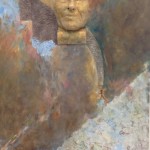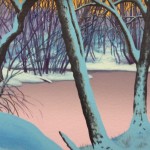One New Painting: Mark III
By Jane Durrell
It’s like a party at The Galleries at Frame Designs, Loveland, where individual works by twenty-six artists fill the walls and more for the third edition of a show called “One New Painting,” running through September 28. The resulting mix of styles and approaches is almost like a gathering where everyone is talking at once and all seem to be having a fine time.
Dan Biggs, owner of Frame Designs, says that two years ago, when Loveland-Maderia Road was torn up for construction and their location at number 9475 could be easily overlooked, the idea for this sort of show emerged as a way to get people in the shop. Biggs, an artist himself, sent out invitations to what was “essentially a family reunion of Cincinnati artists,” most but not all painters. The artists loved it, the opening night was like a reunion, the whole thing was so successful that it’s been repeated each year, although the construction work on Loveland-Maderia Road has long since been completed.
This year’s invitation was succinct: “Bring one new painting. Maybe two if they’re small.” Kevin Kelly is among those who contributed two small works, which in fact enhance one another. Here he turns his accomplished hand to lake-scapes: “Midwinter Evening” and “Frozen Lagoon.” The first is all blues and blacks, while in the second the lagoon is a lavender that almost appears lit from within. Kelly carries this off in acrylic and gouache with a touch of watercolor.
Scrupulous craft, exemplified by Kelly, is found throughout the show. Another shared trait is humor. Bigg’s own work here, “Little Johnny Shit Pants,” is a large vertical painting with a tangle of brush strokes as background for the figure of a school boy hot-footing it to somewhere, an adult face laid on where the child’s would be. Heather Stormer, Biggs’ assistant and assistant curator with him for the show, is also represented by an amusing take, “Clone # 1,” which shows a frantic man in yellow suit fitted out with flying tubes of some unknown substance rushing up a stair. Asked what this is all about, she explains it stems from a film she saw in the making and was intrigued by the character in the yellow suit. In the end the painting itself appears inconspicuously on a wall in the completed film, she says.
Michael Hurst applies his deliberately simple, homage to comic-book style to a Renaissance subject in “Death and the Maiden,” producing a disturbing take on a theme that has attracted artists of all stripes down the years. The New Realists are well represented here. Kevin Muente’s “Down by the Tracks” is a large horizontal scene in muted colors fueled by gray, full of troubling suggestion. A man and a woman are in fact down by the railway tracks, for reasons unclear. The track itself is a powerful element of the composition; a train is retreating from us. Here is a story waiting to be told, but the story line itself is up to the viewer. Jim Menkhaus depicts “The Square” in the left portion of his canvas, instantly recognizable to us Cincinnatians as Mariemont, but a curtain of abstract forms in reds and yellows and blues is arrogantly overtaking the composition from the right. I am confident that Mary Emery, whose idea and desire was the springboard for the pretty village, would be appalled at this painting, but then she would be surprised as well at how upper middle class the place she meant as a haven for working people has become. Is this in any way the subject of the painting? I think not, I think other thoughts are stirring, but it does remind of the frequent distance between the cup and the lip.
Not all the paintings stay on the wall. Cole Carothers’ engaging little watercolor, “View from Lost Lake,” is perhaps four inches by five inches and sits on a tiny, paint-splattered easel that’s less than a foot high. The painting’s “View” is of a mountain, depicted in grays and grayed greens. Also off the wall is Kitty Schroeder’s “Story Book Quilt Revived,” carried out on a four-square column six feet tall, each side with a different subject, tea cups, mother and child, a fish in the sea among them.
Cedric Michael Cox breaks from the prevailing realism with “Face Dancer No. 2,” his familiar sharp-edged shapes seemingly in motion, bright, light colors with darkening borders at top and bottom of the canvas. Roy Johnson’s “Dichotomy” shows us swiftly applied vertical brush strokes in the left section of his canvas, while the remainder of the space is ruled, almost, into horizontal stripes with purple added to the blues and greens of the left portion, producing an effect like looking through the slats of a venetian blind. And one of my favorite works in the show, “Breaking Light” by Michael Scott, manages to straddle two camps. From a little distance it is a small and inviting rendition of slim tree trunks in a crowded forest, touched from the side by early light; up close it dissolves into an absorbing abstract painting, the trees gone as if by edict.
Another piece I liked diverged from realism. “Antefix Alien,” by Laura Livingston, has a complex abstract background from which emerges, center top of the canvas, what might be a death mask in gold paint. Another other element of the work is a tiny black stick figure, incongruously posed against the textured surface of the painting. “Antefix Alien” invites thought and like the show in general is well done.
So, obviously, lots is going on at Frame Designs, not least the interaction of artists many of whom have known one another down the years, whose styles are individual but whose outlooks and values may be shared.








